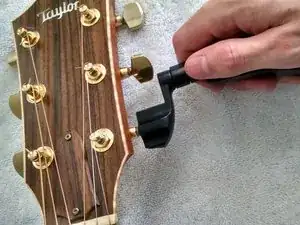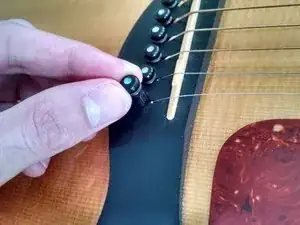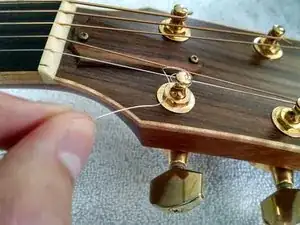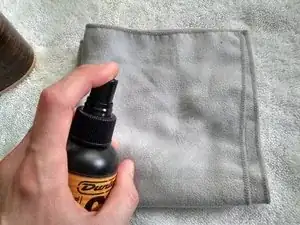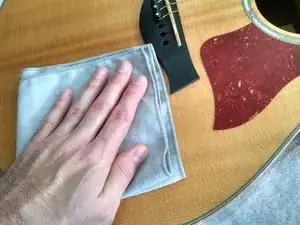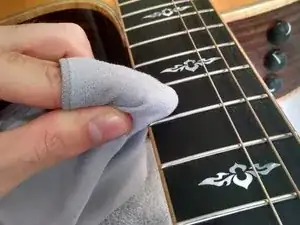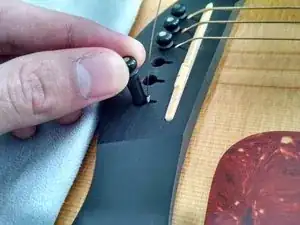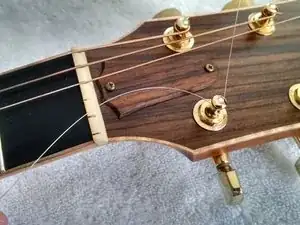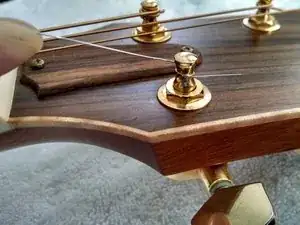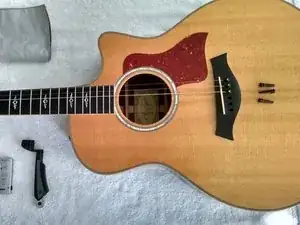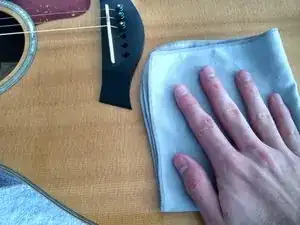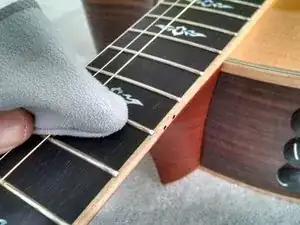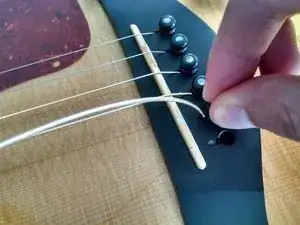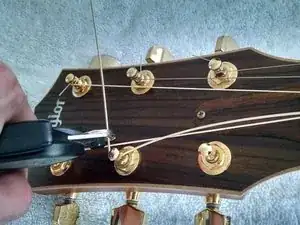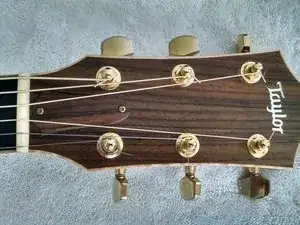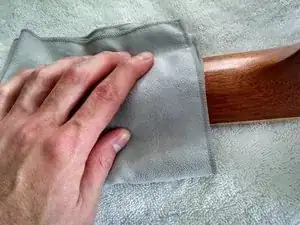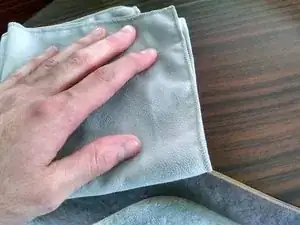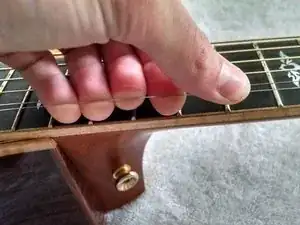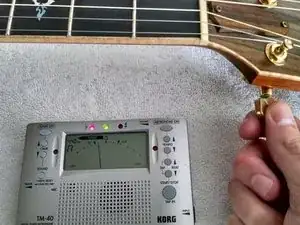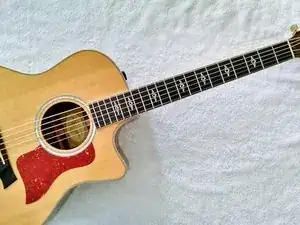Introduction
This maintenance guide will instruct owners of the Taylor 816CE about how to clean the neck, fretboard, and body of the guitar, how to change its strings, and how to break in and tune the new strings. We will go step-by-step to breathe life back into your guitar, making it sound, look and feel new again.
Tools
-
-
The first step to getting your guitar back into shape is to remove the old, dead strings. This will allow access to the fretboard and headstock so they can be more thoroughly cleaned.
-
Do not remove all 6 strings at once, as this would suddenly and drastically alter the tension on the neck, which could lead to warping. If the neck becomes warped, new strings that are applied may end up too close or too far away from the fretboard, causing either fret buzz or strings that are difficult to press down. Instead, remove the first 3.
-
Using your string winder, begin to unwind the smallest (high E) string with a string winder. When it is quite slack - plucking it no longer sounds like a note - pull out the pin where the string enters the bridge on the body.
-
Carefully pull the string out of the bridge pin hole, then unwrap the string from around the tuning peg. This should not require any cutting. Be careful not to scratch the headstock with the end of the string!
-
Repeat this for each of the next two smallest strings (the B and G).
-
-
-
Now that the first three strings are removed, prepare to clean the parts of the guitar that are now accessible.
-
Spray two squeezes of Dunlop 65 Guitar Polish & Cleaner onto a clean microfiber cloth. It is important that you do not apply the spray directly to the guitar, as leaving large amounts of the solution on the guitar for too long can damage the finish.
-
In a small clockwise circular motion with some pressure, rub the bottom half of the front of the guitar starting from the end of the body, across the fretboard to the tip of the headstock. If you feel the damp cloth stop gliding smoothly, apply two more sprays of the solution. You are essentially coating the guitar in a light film of the solution.
-
When the entire bottom half of the instrument has been coated, flip the cloth over to a dry, clean side and repeat the same process in reverse - a counterclockwise circular rubbing motion over the length of the bottom front half of the guitar. Wax on, wax off!
-
Be sure to pay special attention to the fretboard here, scrubbing any sweat, oil and grime from the sides of the metal frets. You can reapply spray if the buildup is significant. Don't worry about getting the solution on the other strings as these will be removed.
-
-
-
Now that the first half of the guitar has been cleaned, you can install the new strings. Open your pack of stings - I recommend Elixir 80/20 Bronze Medium Nanoweb strings for the Taylor 816CE - and lay them out with the packaging so you are 100% certain which string gauge is which.
-
Starting with the smallest string (high E), take the ball end and thread it into the first bridge pin hole. Take a bridge pin (the pins are uniform so it doesn't matter which) and, pointing the small cutout toward the string, push it back into the hole with the string. As you push the pin down, pull the string up until it is snug.
-
Thread the other string end through the hole in the first peg. You may need to twist the peg until the hole is aligned straight with the string. Once the string is threaded , begin twisting the peg until you can tell which way the string is bending.
-
The goal is for the string to bend toward the center of the neck so the the final result looks like a waterfall with all the strings bent toward the center. For the first three strings, this is counterclockwise. After you establish the direction, make sure the string has some slack between the bridge and the headstock to wrap around the peg.
-
When you have verified that you are twisting in the right direction and have some slack, crimp the string in the same direction of the bend, toward the center, by bending it with your finger at a right angle at the peg. No knots are necessary. Cut the excess string about 1 cm from the bend with the cutter part of your string winder.
-
While keeping the string taut with one hand and with your string winder in the other, continue winding the string. When the string begins to overlap the crimp, make sure the winding is above the crimp and the hole in the peg. As winding goes on, move upwards on the peg while ensuring the string remains flush with itself.
-
By this point the string should be getting tight - ensure it is sitting in the correct slots on the bridge and nut (the part that divides the fretboard and headstock).
-
When the string has completely straightened out, stop winding. Tuning will come later. The goal here is to make sure you don't over-tighten and break your brand new string! Repeat this entire process for the next two strings.
-
-
-
Now that the first three strings are installed, you can remove the next three strings. Use the same procedures as in Step 1 starting with the 6th string, the low E.
-
-
-
Repeat the procedures in Step 2 for the second half of the guitar, giving special attention to the fretboard.
-
-
-
Repeat the procedures in Step 3, starting with the 4th string (D). This time, instead of winding the strings counterclockwise, wind them clockwise so they are all bent in the direction of the center. The final look should be like a waterfall, with all the strings flowing inward toward the center of the neck.
-
-
-
Now that all the strings are on and the front of the guitar has been completely cleaned, it's time to clean the back, sides, and neck with the same procedures in Step 2.
-
Give the neck special attention here to ensure your hand glides smoothly across it. You can be liberal with the cleaning solution to ensure you remove all of the grime and oil. Just as before, use one side of the cloth to apply the solution and the other side to polish it down.
-
-
-
Now that all the strings are on and the guitar is all clean, it's time to tune up. Standard tuning from the lowest string to highest string (6th to 1st) is EADGBE. Use your tuner to accurately reach to the desired note.
-
It is always better to tune up to a note than down to it because of the way the tension at the nut works. If you overshoot the note, it is better to tune all the way back down past it and up to it again than to tune down to the note and stop. This will ensure it stays in tune when you begin to play.
-
New strings take a bit of playing to get worn in and stay in tune. Try manually stretching all of the strings by pulling up on them all the way up and down the neck a few times to expedite this process.
-
Play some music and enjoy the sound of your rejuvenated guitar!
-
Enjoy your revived guitar and go learn a new song or two!
One comment
Taylor Dreadnought, Grand Symphony (816), and Grand Orchestra guitars come from the factory with Elixir Medium gauge Phosphor Bronze strings.
Smaller bodies (GC and GA) come with Elixir HD Light strings.
